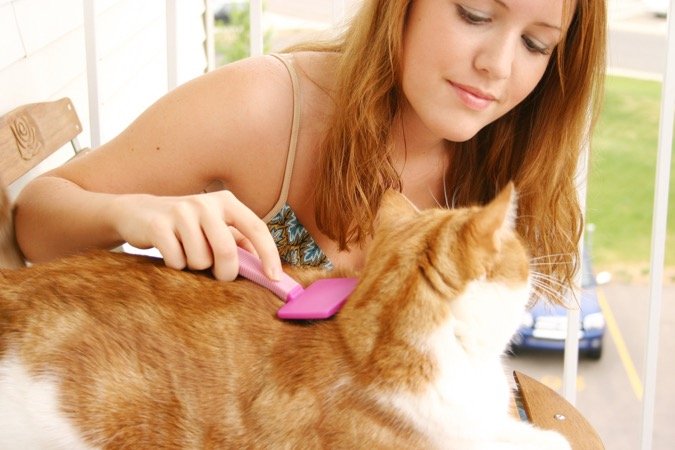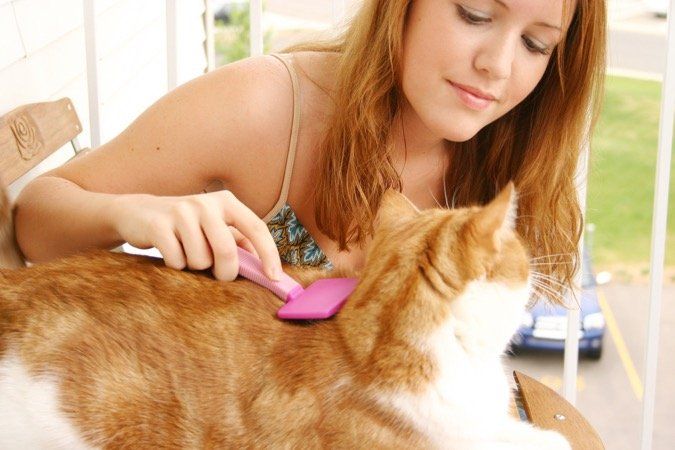Cats are well regarded as fastidious animals, and their meticulous hygiene habits make them a favored pet for many people and cultures. Cats come equipped with their own built-in grooming accessories: the barbed tongue combs out dead loose fur while saliva is a cleaning agent; the front paws become a loofah to clean around the face and ears; the incisors, the tiny front teeth, tease out tangles and remove debris; and the back paws replicate a wide-tooth comb.
But even with these natural grooming tools, some cats need daily or weekly grooming assistance from their owners to truly maintain their coat, skin and overall health. For many cats, and cat owners, it’s a mat, mat world — but it doesn’t have to be if you’re equipped with the right knowledge and appropriate tools.
Matted Fur Coats: Aren’t Cats Supposed to Clean Themselves?
To better understand mats in cats, let’s briefly recap shedding. Seasonal shedding — with the two biggest shedding times of the year occurring in the spring and fall — correlates with the amount of sunlight during the day. However, indoor cats shed year ‘round due to the constant artificial light in our homes; so instead of two heavy bouts of shedding, indoor cats experience continual light shedding. And it is the sloughing of dead hair that contributes to the baneful matting in a cat’s fur.
Mats tend to form in hard-to-reach places such as under the front legs (armpits), stomach and the rear area around the base of the tail, flanks and sensitive nether regions. “Mats in cats are generally different from those in dogs and humans,” explains Lynn Paolillo, certifier and head instructor at National Cat Groomers Institute of America, Inc., in Greenville, South Carolina. “Instead of just tangled hair, cat mats are caused by an excess of dead coat that sheds out and greasy, oily skin. The dead coat clumps together with oils, eventually becoming large and hard mats. This pelting is similar in texture to a Brillo pad.”
The luxurious coat of long-haired cats obviously requires more grooming to maintain those illustrious good looks, but most cats are prone to matting. Short-haired cats are not exempt — excessive shedders are susceptible to mats. Senior cats have a greater difficulty grooming themselves in part due to arthritis and the stiffness that naturally comes with advancing age. The coat and skin health in older cats deteriorates as they age plus their skin produces excess oils, explains Paolillo. And overweight cats need extra help grooming simply because they cannot reach all parts of their bodies, and therefore are also prone to matting.
“The color of the cat can also have an effect on how quickly they mat. Some colors mat faster than others, as the hair is more cottony in colors like cream, blue and some white cats,” says Paolillo. “All cats are at risk of matting, but age, health, the amount of coat they have and color will affect how quickly they mat.”
Mats are much more than an aesthetic problem — they also can cause discomfort and lead to dermatologic problems. Cats have thin, sensitive skin and mats pinch the skin to the point of being painful, and even hindering movement.
Paolillo says that mats can cause skin irritations and bald spots and hide conditions such as fleas, ticks and wounds, among others.
Regular grooming sessions are a method of proactive prevention to taming the unruly tangles before they become a matted mess. Starting early with kittens is the best approach, but even wary adults can be gradually desensitized to the grooming process by starting with short sessions and associating the task with positive rewards like treats and special attention. The proper tools are a must.
Paolillo recommends using a metal comb with tines that are smoothed or ground down — not a flea comb — to remove the excess hair and distribute natural oils in the skin. She says brushes (pin brushes, natural bristle brushes, and de-shedding rakes) are ineffective and too harsh for a cat’s sensitive skin, and that only metal combs are used at her salon.
When combing your cat, be gentle; pulling and tugging at mats and tangles hurts your sensitive-skinned cat. As a child, did you ever fall asleep with gum in your mouth only to find it in your hair the next morning? Well, think about what it would feel like trying to comb out that mess!
Professional Groomers to Help with Matting
© Johanna Goodyear | Dreamstime

Even when you’ve done your very best and followed a grooming routine with your cat, chances are your cat may still get some mats. Of course it’s important to remove them as soon as possible, but sometimes the severity can get overwhelming — for example, if you’ve been traveling and the regular grooming schedule has been thrown off. It is probably time to call in a professional groomer.
According to Paolillo, there are different ways to remove mats and the technique used greatly depends on the severity, the location, your cat’s skin condition and your cat’s tolerance to the grooming process. Smaller mats can be gently combed out once the coat is clean and dry but larger, severe mats should be shaved out by a professional groomer. “Cats should only be shaved by someone who has been trained to do so safely, as cat skin is very delicate and can be cut easily with sharp equipment,” stresses Paolillo.
Experts recommend that you build a relationship with a professional cat groomer before your cat becomes matted. Starting early in a kitten’s life teaches them that the salon isn’t a scary place. For those cats who don’t travel well or get too stressed, there are mobile groomers available for you to schedule an appointment in your home. “Cats are prone to stress-related medical problems, so it’s important to make the cat comfortable with the process,” she says. “Regular appointments with a professional cat groomer can prevent mats and other problems, including greasy ears, ingrown nails, hairballs and excessive shedding.”
Not only can early preventative care help a cat stay mat-free, the groomer can help alert owners to any changes in behavior or health, says Paolillo.
Cats are naturally sharp-dressed, haute-couture creatures that maintain themselves to high standards. They need our assistance with grooming to keep their coats and skin in optimal condition. With the proper tools — which may include the help of a professional groomer — patience and perseverance, you can banish mats.




